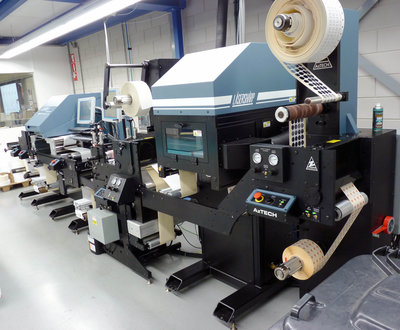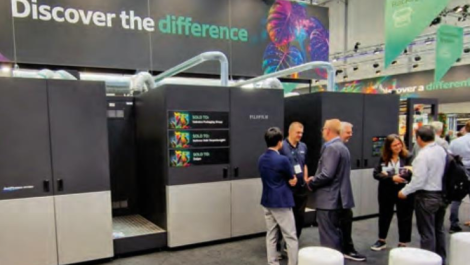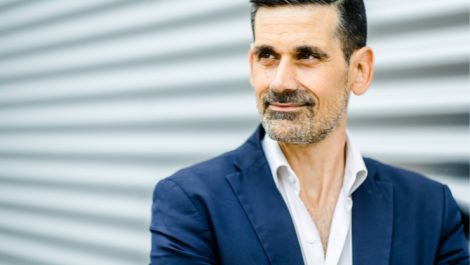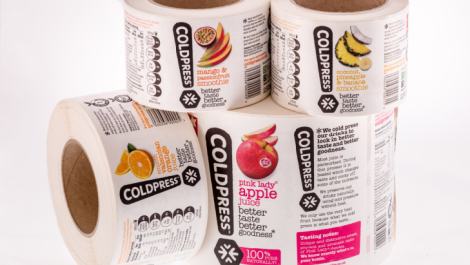The Colordyne and LasX systems on site at Labeltech in the Netherlands
Speedy digital printing and laser cutting have been married together in a unique new installation at Dutch label producer Labeltech. Andy Knaggs went to see for himself.
Peter van Leeuwen has a new question for his customers: do they want digitally printed labels in the old fashioned way or the new way?
Two months ago, Mr van Leeuwen’s company, Labeltech in IJsselstein, near Utrecht in the Netherlands, took delivery of Europe’s first Colordyne production class digital label presses – two CDT 1600-PC systems, one in a basic printing configuration (called a Sprint), and one (called Laser Pro) with an integrated inline laser cutting unit from LasX.
It gives the company something of a unique offering in Europe. The Colordyne presses are based on the super-fast memjet print heads, which in the systems at Labeltech can print at 49 m/min at 1600 x 1200 dpi resolution. The printing systems alone deliver close to CMYK flexo look and feel with the flexibility of digital. Add to this, laser die-cutting, etching, scoring and perforating inline, with no need to pay for expensive dies, and the company, which has never invested in production class digital technology before, can start talking lead times and flexibility and creative formats in short runs that will give it real market differentiation.
In fact, memjet has a new, even faster head called Aspen, which goes up to 225 fpm at 1600 x 1375 dpi, but these are not yet in Mr van Leeuwen’s systems.
All about the service
Mr van Leeuwen has been in the label industry since 1979. He said he had never previously had a good feeling for label production with digital, and was waiting for inkjet to come of age. However, he had been following closely the progress of memjet and the US firm Colordyne, which is one of only three OEM manufacturers using the memjet technology. Two years ago at drupa, he met up with Colordyne founder and chief executive Gary Falconbridge, himself a label converter for almost 30 years, and they discussed moving forward on a project. Colordyne’s European reseller Delphax also became involved – Delphax has a Colordyne Sprint for demonstration purposes at its Crawley facility.
There are some customers for whom this technology could be perfect. One of these customers buys two million printed labels a year from Labeltech, with 600 different designs that are frequently changing. The company is in the process of establishing a web portal for this customer to manage its designs and print ordering.
‘We are not talking about cost per label at all now, we are talking about service,’ he said. ‘We are giving them a solution, a tool for an inconvenience that they have with their labels. The Colordyne gives us flexibility, even for big runs where they need some of the order quickly.’
He contends that there is a real need in the market for the solution that Labeltech can now offer – short run, very high quality, variable content, and indeed variable format with the laser cutting. This last is really something to watch – almost like a bolt from the heavens that in an instant is able to make intricate and precise die-cuts.
New markets
Existing customers are in industrial, logistics, healthcare and pharmaceutical sectors, and not so much in areas such as food and beverage. This technology will open new doors however, Mr van Leeuwen said. ‘We will certainly be able to move into those sectors because this technology provides the quality needed and the flexibility for smaller runs, which is also part of their need.’
Steps will also be taken to co-ordinate the colour output from the company’s digital and flexo presses, but it is the Colordyne digital press that will be used to produce the master print that flexo will have to match, making it easier to up or down-scale order volumes across the different technologies. ‘We anticipate that the bigger jobs will come back in smaller numbers that we will need to do on the Colordyne. We know these customers will never be only flexo or only digital; it does not matter to the customer. To him it is quality, lead time and price.’
Mr van Leeuwen expects that digital print will become about 30% of turnover, and therefore would not be surprised if the initial Colordyne installation grows in time. Work will move over from the Mark Andy presses, and new types of work are being sought. ‘We have some hot irons in the fire,’ he said, with characteristic Dutch informality.






